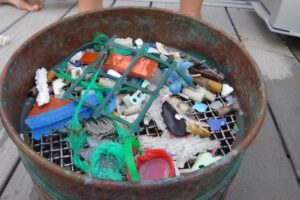These days, it is common to see long trucks carrying plastic waste retrieved from the sea and heading toward various waste recycling plants in parts of Accra. While, the retrieval, transportation and recycling of plastic waste has become an economic activity, no well-meaning Ghanaian should be glad that our country is losing control over the indiscriminate dumping of plastic and other waste into our water-bodies.
Plastics is the name given to a group of substances mostly made from carbon-based molecules arranged in many repeat units (n) in a long chain known as a polymer. There are different types of plastics depending on what is attached to the carbon. Most plastics are derived from petroleum, although some newer ones, known as bioplastics, are derived from building blocks produced by microbial fermentation or from corn syrup. Chemicals including colourants, foaming agents, plasticisers, antioxidants and flame retardants can be added to different types of plastics to give them specific qualities such as colour, texture, flexibility and durability.
Plastic as part of life
“No one within a period of 10 minutes isn’t touching something that is made of plastic,” said Professor Andrew Holmes, an emeritus professor at the University of Melbourne and a polymer chemist who has developed special plastics for flat-screen TVs and solar cells.
In a recent article, Prof. Holmes was quoted as saying that plastic is used in everything from the keyboard and pen we use to our glasses or contact lenses, the Teflon on our frying pan and the banknotes in our wallet. “Plastic is in your clothes, phone, car, mattress and TV screen. “Plastic can be flexible or rigid, and its lightness also makes it very appealing,” said Professor Holmes.
However, despite the benefits of plastic in various sectors of the production line, the improper disposal of plastics – particularly those designed to be used only once ( such as packaging) – has become a major environmental issue across the world, including Ghana. “The ocean is full of waste because humans have disposed of it carelessly,” said Professor Holmes. So how big is the problem, what happens once plastic goes into the ocean, and what can we do about it?
Environmental scientists and advocates have indicated that the manufacturing and use of plastic materials by humans all over the world has grown exponentially since the 1950s. In mid-2019 the world woke up to the scourge of indiscriminately using plastic products. Currently, an estimated nine million people worldwide are employed in plastic production and processing. While some plastics are lightweight and affordable, a category called ‘single-use plastics’ has been proven to pose harmful risks for the environment, human health and economies.
This means that plastic products have associated impacts on society once they are produced for domestic and industrial use. These impacts can potentially translate into risks, or opportunities for businesses. In this article, the focus is on the risks of plastic waste and its effects on the environment. In subsequent articles, I will discuss the business opportunities plastic waste offers. I will explain why it makes business sense for companies that package their goods in plastic to ensure their packaging is recyclable or properly disposed of.

Carbon emissions
According to a UNEP (2014) Report, approximately 4% of oil production is used as feedstock and another 4% is used to fuel the plastic manufacturing process – as well as other resources such as natural gas, water and chemicals. Naturally, extracting and processing these raw materials into plastic feedstock generates carbon emissions and other air, land and water pollutants. Also, plastic pellets from the manufacturing process may enter the waste stream and the ocean in the form of microplastics, which are small particles of plastic.
Scientists say microplastics are easily ingested by sea life, and now even outweigh the impact of other microscopic organisms collectively affecting sea life. Other negative impacts may arise from chemical additives used in manufacturing plastic items. Chemical additives are added to plastic feedstock to enhance their performance in terms of strength and heat resistance. These include fillers, plasticisers, stabilisers, flame retardants and colourings.
Environmental advocates say these toxic substances can leach out of plastic into the environment, affecting the health of wildlife. Besides, some additives are of concern to human health. An example is the potential leaching of bisphenol from plastic containers into the food it contains. Sadly, in Ghana virtually every food cooked for human consumption (from rice to banku, kokonte, yam and fufu) is now wrapped in some form of plastic product – despite repeated warnings by medical experts that the use of plastics in packaging hot food for immediate consumption has health implications. The ‘plasticisation’ of food and drinks has become the new way of life in Ghana, perhaps driven by misleading advertising by plastic companies and poor consumer education and enforcement by state agencies.
Another danger is the possible migration of flame retardants from plastic computer enclosures into dust that humans breathe. Plastic presents further risks and costs once it is disposed of at the end of its life. Globally, between 22% and 43% of plastic waste is disposed of in landfills – where the resources it contains are wasted. Landfill sites can damage local communities due to their undesirable nature. If plastic is mixed with other materials, sorting the waste to collect useful materials becomes more complex, costly and dangerous.
The cost of littering
Waste management, while necessary and better than littering, is costly and wastes resources that could be put to good use through recycling. Inadequate waste management is expensive to society and often not internalised by businesses. In developed countries, collection costs range from US$20 to US$250 per tonne depending on the region, while landfill costs US$10 – US$100/tonne and incineration with energy recovery US$40 – US$200/tonne. In a poor country like Ghana, improper waste collection and management makes the process more expensive than in developed countries.
According to the World Bank, the quantity of waste and related cost is likely to double by 2025. With many countries unprepared to handle this increase, waste and resource management will be an increasingly important issue in the years to come for companies; particularly those who operate across borders. Experts say plastic is one of the toughest waste streams to handle, and though the weight of plastic waste might not be as big as that of other materials, its durability and volume often account for a large proportion of a country’s waste issues.
The Plastic Menace
Plastic is the most common type of marine litter, comprising up to 80% of total waste in marine litter surveys. Most (over 80%) comes from land-based sources, with marine-based activities such as shipping, cruise lines and fishing accounting for the remainder. Once littered, it is costly to recover and becomes a multigenerational problem due to its long degradation time. Although it is typically only considered an eyesore, its impact is felt throughout our communities, environment and, increasingly, the ocean. Litter has an impact on land use, transport, animal and human health, safety, flooding, community spirit and clean-up costs.
It often makes its way to the ocean over time, due to its light weight and durability – blown by the wind or via rivers and drains. While there is much uncertainty about extent of the problem, a report by the United Nations Environment Programme (UNEP) estimated that eight million tonnes of plastic went into the ocean in 2010, and since then about six million tonnes of litter enter the ocean every year…including some eight million items every day. The international study calculated that 192 nations produced a total 275 million tonnes of plastic waste. The largest amount of this waste was produced by China, at 1.32 to 3.52 million tonnes. This was followed by Indonesia, the Philippines, Sri Lanka and Vietnam. This figure is likely to be an underestimation, as the underlying research was published in 1975.
Studies show that levels of litter in the seas are increasing despite efforts to control the problem. Industry bodies, businesses, governments, civil society and international institutions are recognising the issue’s magnitude and the need to tackle it. Over two-thirds of plastic litter ends up on the seabed, with half of the remainder washed up on beaches and the other half floating on or under the surface, according to the UNEP Report.
Larger items such as plastic bags, plastic strapping for packages and abandoned fishing gear can strangle marine animals. Bottle-caps, plastic cutlery, pens and cigarette-lighters can be ingested and harm animals through internal damage and starvation. Over time, ocean currents drive plastic waste back to the sea’s surface.
Threat to Marine Life
Studies have found that there has been a 40% increase in the number of species reported to be affected by ingestion and entanglement between 1997 and 2012, across all marine debris types. Ingestion of microplastics may also have severe impacts on wildlife. In addition to intentionally manufactured microplastics, other microplastics are created as larger items of plastic break down in the environment. Plastic waste found in the marine environment can potentially leach chemicals into the environment as well as attract and communicate hazardous chemicals from the ocean to wildlife.
Apart from destroying marine life, plastic waste has a direct socio-economic impact on countries and communities. In the maritime sector, there are increasing cases of vessel damage often caused by plastic waste trapped in the propellers of ships. It is estimated that the approximate economic cost of marine litter is US$17m-US$28m per annum in Scotland. Local authorities have to bear the cost of cleaning up plastic litter from beaches. In the UK generally, the annual costs are put at US$24m, while in the US communities on the west coast spend more than US$520m per year to retrieve litter from the sea. Similarly in Ghana, the Coastal Development Authority and Metropolitan and Municipal Assemblies – in collaboration with the Ghana Tourism Development Authority – are spending millions of cedis to clear plastics floating onto the beaches.
In 2020, the Asia-Pacific Economic Cooperation (APEC) estimated that the cost of plastic waste to tourism, fishing and shipping industries was US$1.3bn. It is evident that the plastic menace negatively affects ecosystems and tourism everywhere, including Ghana. So, the earlier government and its agencies become proactive in addressing the plastic menace the better for us and our environment, seas and water-bodies on which we depend for sustenance.
Reference
UNEP (2014) Valuing Plastics: The Business Case for Measuring, Managing and disclosing plastic use in the Consumer Goods Industry










